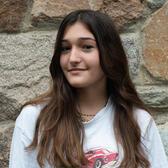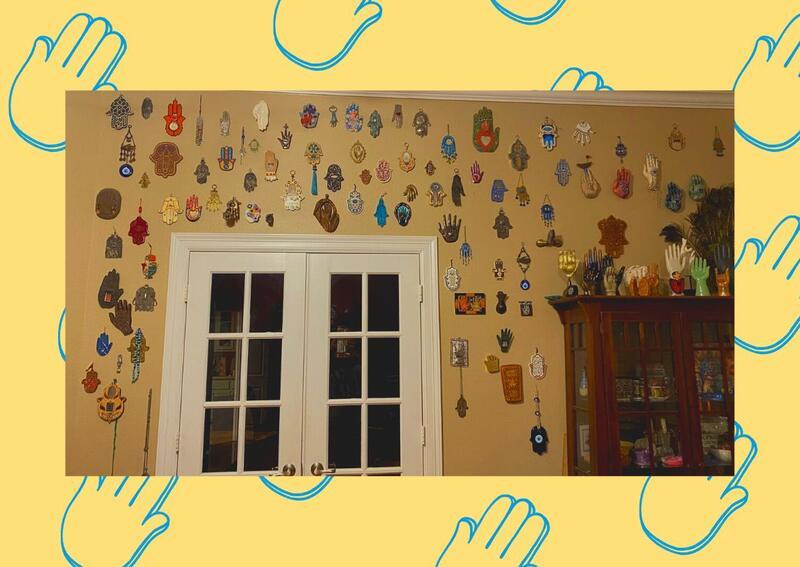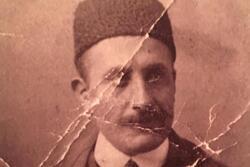Unity through Symbolism: The Hamsa
The Hamsa, or the Hand of Fatima, is a symbolic hand which represents protection in both Jewish and Islamic cultures. Relating to Fatima, the daughter of the Prophet Mohammed (the founder of Islam), and Miriam, the sister of Moses, this symbol directly correlates back to various religions and cultures. As a teen with a Muslim-Palestinian father and a Jewish-American mother, this symbol has always meant a lot to me and my family.
Growing up in a mixed-culture and mixed-religion family is confusing. As a young child, I didn’t question my personal identity as often as I do now. Simply, I knew my family would practice certain holidays and important spiritual days in both religions, and I didn’t think much of it. Nowadays, there's an internal grapple with the two sides of my identity, but also a beautiful mix of two cultures coming together as one around me. This is constantly shown through the various holidays we practice, trips to see family around the world, flavorful meals, and my personal favorite, the symbol of my family: the Hamsa, or, the Hand of Fatima.
The Hamsa/Hand of Fatima is a hand that holds many different meanings to a wide range of cultures, including Judaism and Islam. Hamsa, or “khamsa” (خمسة) in Arabic, means five: a number associated with the Evil Eye, the five pillars of Islam, and of course, the five fingers on the symbolic hand itself. Providing protection from the Evil Eye, this symbol is especially popular amongst both sides of my family, being Middle Eastern and Jewish.
Hung throughout my house, my family has over one hundred Hamsas made and purchased from around the world. From Jerusalem, Jordan, the Dead Sea, art fairs around the world, Morocco, and even made by me, the Hamsa truly is a symbol appreciated and used by all of us on both sides of my family. Our personal collection has a wide range of hamsas including one constructed from olive wood made in Madaba, Jordan, some from our first trips to Morocco, and some from our first trips to various places throughout the Middle East. In one of the rooms of my house, the entire wall is completely covered from top to bottom. My mother started a small collection of Hamsas years before she met my father as a way to represent her interest in Jewish symbolism and curiosity about Jewish identity. After their marriage, she merged this collection with Hamsas my father has found and collected throughout the world as a way to represent this mix of cultures. A symbol of protection in various religions and cultures is also used as a symbol of unity for a positively messy mix of backgrounds in my family.
Our wall of Hamsas is also located in our “library,” a room that holds within it two large bookshelves, one with historic Palestinian books, and one full of Jewish and medical books pertaining to my mother’s profession as a gynocological oncologist. In addition, this room has certain Middle Eastern art pieces that have been purchased around the world that hold specific meaning to us. In a way, this room represents the journey of my parents' marriage. From worries about non-acceptance from others, problems for me, and initial hesitant feelings from their parents, my parents' journey together has contained many challenges. However, through their marriage and my life as someone with an interesting background and mix of cultures, they have brought this idea of unity to our everyday lives, and to the people around us.
For me, the Hamsa means something slightly different to that of my parents as I am the merger of the two cultures. The Hamsa is a fusion of multiple cultures, similar to that of my family. Especially in a world where I constantly will be working to be connected with both sides, the Hamsa and I have that characteristic in common. In recent years, I have started making my own Hamsas for my family's wall out of clay, and sometimes embroidery. This is my way of taking a symbol used by my family, and reinterpreting it to fit my personal identity. On the embroidered Hamsa, I include traditional greetings in Hebrew and Arabic, Shalom and Salam, as well as an olive branch, to represent unity, peace, and the concoction of backgrounds we possess.
Part of growing up in a family with such a mixed background is finding my path to understand, embrace and balance the backgrounds within myself. I’ve learned various recipes and traditions from my family such as our traditional hummus, kousa mahshi (stuffed zucchini), musakhan (sumac chicken), matzah ball soup, how to set up a table for Passover, and so many more meaningful parts of my culture. In addition, I’ve involved myself with understanding the community around me through activism groups including clubs at school like Students Demand Action, youth groups, and ultimately writing for JWA’s blog now. It’s been important and beautiful to find my way around life through immersing myself in my cultures, and even adding my family's twist on certain things, especially the Hamsa.
This piece was written as part of JWA’s Rising Voices Fellowship.








A friend of mine was recently in Jerusalem and she said that Hamsas were used there by Jews, Muslims and Christians.
Thank you for the beautiful information. I have been searching for an honest definition. Blessings to you.
Thank you I was looking for this and I find it. Thank you.
Hi - My mother was given a beautiful golden Hamsa charm on a gold chain . She is a practicing Catholic but has several friends who are like family that are Jewish. She wants to know if her wearing the Hamsa is in anyway offensive to either the Jewish or Muslim people of today. I did read that as long as you know the meanings and respect it that is ok, But that was a google reply to the question, We wanted to ask you as a Jewish woman. Thanks so much!!! Kim
An interesting write,and learned a couple of things, about Hamsas. I have a lot of time on my hands being Retired and enjoying it, but I'm starting to get bored. I always liked them as jewelry never thinking of collecting, so thank you for your family history,mine is of America First people today,I don't understand,they live here, but don't appreciate the USA, sorry to ramble on ,so thanks again, Lou
The Hamsa was not Jewish. It was from Mesopotamia. It was always an Islamic symbol, an amulet. Jews in the area ultimately adopted it, though it is essentially a graven image; an idol. Jews do this when surrounded by religions other than our own. We assimilate and essentially, "go astray." Hamsas are not something we should value, as they essentially represent the Hand of G-d (for Jews), Fatima for Islam. It's kept as an amulet against the evil eye, which of course, is superstition, another breach of our commandments. I think our problem is basic ignorance and a big case of FOMA. We want to be part of everything, but we don't enough about who WE are to make wise discernments.
In reply to The Hamsa was not Jewish. It… by R' Sheryl
This is remarkably ahistorical.
The oldest archeological hamsa is found in Mesopotamia, in 2000 BCE. That is a >2600 years before Islam even exists (610 CE). The most closely related extant descendents of the Mesopotamians are the Assyrian people, who are not Islamic.
Additionally, there are ancient israelite tombs dating to 800 BCE with hamsas on them, 1400 years before the existence of Islam.
The symbol is literally older and been used by Jews longer than the Magen David. Is it uniquely Jewish? No. But neither is the Magen David, which originally appeared in ancient alchemical writings. However, it is absolutely not Islamic.
Finally, Jews and kabbalists have been using amulets for thousands of years, whether it's an hamsa or an amulet of Lilith. You don't have to like them or agree with them, but they are a deep part of our history and identity.
Side note: superstition is not inherently wrong in Judaism, only divination and fortune telling are expressly forbidden. Jews are some of the most superstitious people I know, we don't (ashkenazim at least) even name our children after living relatives in case the angel of death makes a mistake. Sephardim are more attuned to evil eye superstition, which is also very ancient. Spitting three times? Etc. Cmon now, THIS IS who we are and have been, whether we like it or not.
This is truly an inspired essay, and a superbly written piece. I wish I had a way to make this "go viral" so millions of others could stop and reflect and commit to try to do more like I did when I read it. Well done! Thank you!!
I love this story Leila. I’ve been so upset about the war between Israel and Hamas and a few days ago my hamsa pendant broke. I’ve been searching for a new one and found your article. Thank you for sharing your family with all of us. It gives me hope.
Laurie
Beautiful article. I really needed to read this today. Thank your parents for being who they are. You are blessed.
Great Story! You might like the art of EleyOri (she’s on Etsy). She does beautiful peaceful art, and even a hebrew and arabic design “do good, seek peace, and pursue it”. I think it was made for you! I’d even buy it and send it to you 🪬💗🪬💗🪬
In reply to Great Story! You might like… by Ashley Hajski
This is so lovely, I'd love that! I'm glad you enjoyed my article. 🪬💗
I found this piece when searching for information to explain the beautiful hamsa my daughter bought me in Morocco to a friend. My daughter, whose heritage includes 7 great-grandparents of Jewish descent, and one great-grandmother a devout Christian who married a Jew, is married to a Moroccan man raised in but not nowpracticing the Muslim faith. They are expecting their first child next year. With the recent terrible events, I hold on to her story and yours as signs of hope. Thank you for this beautiful essay.
I enjoyed reading your story. Please write more stories about the mixture of cultures. I too hv mixed cultures jewish and cuban, and love the hamsa and collect them. I used to be religious jewish orthodox growing up but as an adult i am still a jew just not practicing judaism as much. after God showed me a miracle, which was too long to write about here, all of the atrocities that the jews were doing to Arabs had me rethinking judaism. And i was torn. Meanwhile i am still an avid follower of God and i am against the violence and land robbing of Palestinian people. Please continue writing telling your story. So people can see the two can come together and live in peace. All is possible w love possible.
Correction, Muhammad (pbuh) was not the founder of Islam, he was messenger of God just like moses, jesus and Abraham. The "Hamsa" has no significance in islam and is not even mentioned in Islamic sources like the Quran or Hadith books.
In reply to Correction, Muhammad (pbuh) … by Jessica linkov
Thank you for sharing this post Leila and thank you for this correction Jessica; you are right. Furthermore, to believe that symbols and amulets such as these will protect you from anything is outright shirk and should be totally avoided. The truth is that these objects/signs have zero power and cannot benefit or harm; all power is with Allah. Its also worth to note that I am not judging or hating anyone, just simply sharing correct information according to the Islamic teachings regarding this matter.
I am thoroughly impressed with your research. 10/10.
Leila, you have beautifully captured the meaning of the Hamsa and helped us to see the powerful place it holds in your life. Thank you!